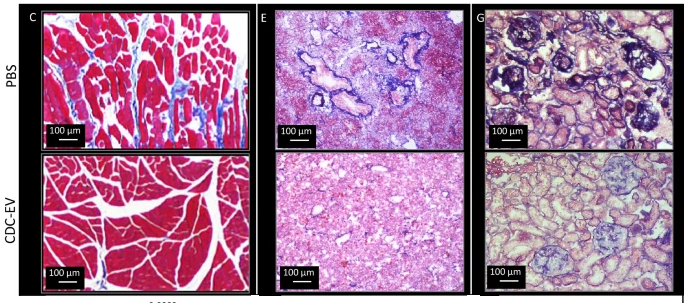
Extracellular Vesicles(EVs) have only been studied in the 21st century.Think of them as natural lipid nanoparticles, or endogenous viruses.They transmit information around the body and theyre small enough to be exhaled and carried in the air to communicate with other individuals and even other species.
EVs are encapsulated in fats that facilitate entry into cells, and inside they contain proteins, RNA, DNA, lipids all of which carry information.EVs are a universal biological language, a barely-explored medium of communication.Last week, anextraordinary paperwas published demonstrating the rejuvenation potential of EVs from very young animals injected into old animals.The authors come fromSmidt Heart Institutein Los Angeles, and their primary field is cardiology, not gerontology, so they focus on heart-derived EVs and benefits for rejuvenating the heart.
But the benefits they observe go well beyond the heart and include lifespan in rodents and rejuvenation of human cells from rat-derived EVs.This research should be understood in the light of parabiosis experiments bythe Conboys,Rando, andothersand in particular to the rejuvenation technology ofHarold Katcher.I am grateful to Harolds partner, Akshay Sanghavi, for alerting me to this publication.Katchers blood-derived rejuvenation serum is called E5, and Akshay has told me that E5 includes EVs as well as a wide range of proteins.
The current article suggests the possibility that it is wholly the EVs that are responsible for the benefits of E5.Indeed, the authors repeated their experiments with (1) whole blood plasma, (2) plasma with the EVs removed, and (3) just EVs.They found rejuvenation effects associated with whole plasma and with EVs alone, but not with plasma minus EVs.
If this holds up, it is the studys most important finding.Akshay told me that EVs are easier and cheaper to isolate than the molecular constituents of E5 (proteins).For all those involved in parabiosis and plasma exchange research, I suggest that it should be an immediate priority to replicate the Smidt findings thatallof the rejuvenating power of young blood is contained in EVs.The Conboys might be interested in asking whether the pro-aging effect of plasma infusions from old to young animals is also an effect of EVs.The state-of-the-art EV separation technique for large throughput is called anacoustic nanofilter.
Ultrasound pressure can be tuned to separate a particular size of particle in a specially-designed medium.If I were advisingYuvan, I would suggest that they develop an expertise in acoustic nanofiltration ASAP as a next generation replacement for their plasma fractioning technology.ExosomesExosomesare the most common type of EV, and probably the most relevant to aging applications.They seem to be a general vehicle for inter-cellular and inter-individual communication.
The study of exosomes is in its infancy, but it is already known that exosomes are tagged in a way that recipient cells can distinguish and choose which exosomes to pick up and read the message.One area of exosome activity that has been studied is the communication of antigens to the immune system.A particular type of exosome includes foreign proteins that are potential invaders, and they are shared not just within the body but through the air.When you think of herd immunity, consider not just the contagion of people who carry disease but also the information about what diseases are in the air that is transmitted in social interactions.When communities and whole countries were locked down during COVID, one consequence was to prevent uninfected individuals from learning and preparing an immune response to the virus through the sharing of exosomes.In the nervous system, exosomes have been found to help in myelin formation, neurite growth, and neuronal survival, thus playing a role in tissue repair and regeneration.
[ref,ref,ref,ref,ref,ref] It has been demonstrated that the mesenchymal stem cell exosomes themselves can act as a therapeutic agent to help [repair] tissue injury.[ref,ref,ref,ref,ref,ref]Microvesicles are, as far as I can tell, a kind of fat exosome.They are as large as bacteria, whereas exosomes are closer to the size of viruses, but the range of contents and hypothesized functions is the same.Apoptotic Bodies another potential target for EV therapiesThere is also a specific EV type that apoptotic cells send to induce apoptosis in other cells.
Apoptosis is programmed cell death, playing an important role in self-destruction of diseased and cancerous cells.However, aging involves a cascade of apoptosis in healthy cells that leads to loss of muscle tissue (sarcopenia) and brain cells (neurodegeneration).Apoptotic bodies are the type of EV that triggers the apoptosis cascade, and I speculate that removing apoptotic bodies from the blood will have future potential as an anti-aging therapy.
Apopototic bodies are even larger than jumbo microvesicles, so it should not be difficult to separate them in medical applications.It is a reasonable guess that the effectiveness of senolytic therapies is directly related to a reduction in apoptotic bodies, which are secreted by senescent cells.(These are my own speculations, not mentioned in the paper that Im reviewing here.)The new researchRejuvenating effects of young extracellular vesicles in aged rats and in cellular models of human senescence by Grigorian-Shamagianet al, inNature Scientific Reports.
Senior author = Eduardo Marbn.The authors extracted EVs from neonatal rat hearts, and applied them to cell cultures and injected them into older live rats (22 months).They used whole plasma and plasma minus EVs as controls, establishing that it is the EVs that carry the benefits.They extracted corresponding EVs from heart cells of neonatal humans, and applied them to cultures of human cells.They found EKG evidence that hearts were functioning better in treated animals.
Insulin resistance was blood sugar were reduced.Exercise endurance increased in treated animals, while declining progressively in controls.They found that pliability of tissue was restored toward young levels.Hearts, lungs, muscles, and kidneys all improved their function in treated rats.Tissue samples (muscle and heart) look better in ways that I dont pretend to understand.Old rats were treated with four monthly infusions, then kept for 16 weeks more before sacrificing all animals.During those 16 weeks, 6 of 14 control rats died and only 3 of 36 treated rats.
My calculation (Fishers exact test) indicates life extension with a 99% confidence level.Tests were conducted on two human cell cultures: fibroblasts from middle-aged donors treated with human EVs, and cardiac cells treated with rat EVs.Fibroblasts increased reproductive capacity, decreased apoptosis, and a more youthful transcriptome.Similarly, cardiac cells exhibited better self-assembly and a more youthful transcriptome.The bottom lineIn case you havent yet read between the lines, Im excited about this work.
I would have liked to see results of some Horvath clocks and a hat tip to the Katcher preprint, but in other respects, I find the research quite thorough and convincing.A major question in plasma exchange research has been the identification of the active component, out of thousands of protein species.This is only one study, but it suggests that researchers look at the activity of EVs rather than proteins or RNAs.A crucial question is whether EVs from other mammals can be used to rejuvenate human tissues.
This study suggests yes, but the demonstration was limited to cell cultures and no direct comparison was made between treatment with human-derived and rat-derived EVs.The author has not responded to my email requesting any data relevant to this question.If animal EVs work in humans, the therapeutic market may soon open; EVs should be easy to extract from the blood of young animals that are being slaughtered for meat.
If not, we face a major ethical dilemma, as aborted and stillborn infants will support only a tiny fraction of the potential demand for rejuvenating EVs.EVs from young human donors can probably be extracted but its a lot to ask of our children.The authors suggest that EVs could be manufactured from human cell cultures.
Given that allogeneic CDCs [cardiosphere-derived cells] are already in advanced testing and have proven safe to date, such cells can be used as manufacturing platforms for EVs, enabling rapid progress to clinical testing in a variety of aging-related disorders.
Publisher: Josh Mitteldorf ( Read More )

